AMD Ryzen 5 2400G and Ryzen 3 2200G Integrated Graphics Frequency Scaling
by Gavin Bonshor on September 28, 2018 12:30 PM EST- Posted in
- CPUs
- AMD
- GPUs
- Overclocking
- Zen
- APU
- Vega
- Ryzen
- Ryzen 3 2200G
- Ryzen 5 2400G
Ryzen APU Integrated Graphics Scaling
Our of our promised Ryzen APU scaling articles, overclocking the integrated graphics was the most requested. Given that the Ryzen 5 2400G and Ryzen 3 2200G are marketed towards gamers on a budget, the gaming performance is perhaps the most important aspect to most users looking to purchase one for their system.
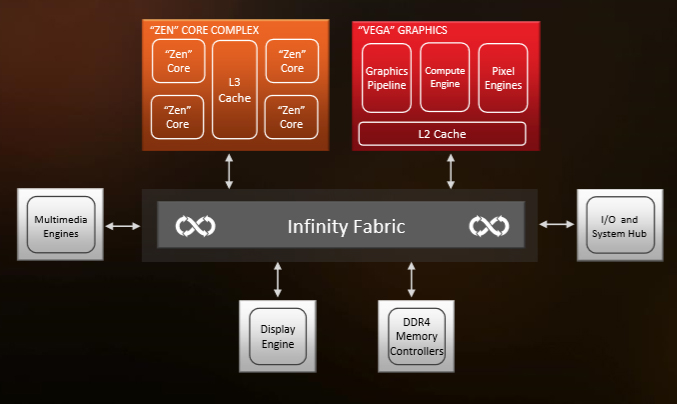
The Raven Ridge APU layout Highlighting the Infinity Fabric Interconnect
We have seen that the Infinity Fabric interconnect used within the SoC benefits from the use of faster memory in our Ryzen APU memory frequency scaling testing - because the Infinity Fabric and memory speed are directly linked, the CPU cores and GPU cores can communicate between the different areas faster. When overclocking a system for more performance, it all comes down to identifying the bottlenecks. Multiple bottlenecks can be in play at once, such as CPU frequency, GPU frequency, memory speed, and interconnect speed. As our set of articles on APU scaling have progressed, the final one left to analyze was GPU frequency. Hence, this review.
Scaling the APU, One Step (50 MHz) at a Time
For our overall analysis, we are splitting the data into two sets.
First up is the performance difference when simply overclocking the integrated graphics. Stepping up the frequency, as shown on the previous pages, usually increases performance, but here we will tell you how much in all four key areas: 2400G frames per second and percentile results, as well as 2200G frames per second and percentile results.
The second is to compare maximums. We have data now with the maximum tested integrated graphics frequency (1600 MHz) and the maximum tested CPU core frequency (3.9 GHz). The question becomes how much of a difference does overclocking one over the other make for gaming. The answer would normally sound obvious, but this is something we want to quantify. If a gamer has a choice between overclocking the CPU or the GPU, what should the target be, and how much should they expect? This data answers that question.
Group 1: 1600 MHz vs Stock
When comparing the results with the Ryzen 2000 series APUs at their stock settings against an overclock of 1600 MHz yields some good results across the majority of the titles tested in our testing suite.
Starting with the average frame rates, the Ryzen 3 2200G showed the biggest gains across the board, with the biggest benefits of overclocking in more graphically intensive games such as Total War: Warhammer 2 and Rise of the Tomb Raider. The 2400G, with its 28% overclock, pushed above 10% in Warhammer 2 and F1 2017, looks like it did not gain as much as the 2200G, but this is due to the lower percentage gain over the stock performance.
Focusing specifically on the 99th percentiles from the testing, the results given were erratic to say the least. All test results were repeatable across operating system reinstalls, but the 2400G showed regression in Shadow of Mordor and Warhammer 2. By contrast, the 2200G saw gains in both of those titles, a minimum of 8% across the board, and several titles scored around a 30% gain. For a 45% overclock, this is pretty good.
Group 2: What is Better, CPU OC or IGP OC?
In this set of results, we compare the uplift gained from a full GPU overclock to a full CPU overclock. This is to show which component of the chip provides the biggest benefit to frame rate performance in games: CPU or graphics. While increasing the CPU frequency is beneficial in improving performance in computationally dependent tasks such as video encoding, rendering and compression tasks, games should enjoy the graphics much more.
In our 2400G results, the winner between the two is clearly the integrated graphics. The CPU data shuffles around the same frame rates, not offering much benefit, while overclocking the GPU gives at least 5% extra frame rates across the board.
As the 2200G starts off from such a low point, overclocking both the CPU and GPU gets extra performance in almost every title. However, only overclocking the integrated graphics gets a good 10% gain across the board as a minimum, but more like 24%+ on games like F1 2017, Rise of the Tomb Raider, and Warhammer 2.
So while the analysis here is perhaps not as long-winded as our memory scaling and core frequency scaling pieces, the crux is that the integrated graphics is the key factor in gaming performance and despite the Infinity Fabric Interconnect combined with faster memory displaying a positive showing in our Ryzen 2000 series memory scaling analysis, the integrated graphics does offer more from a gamers standpoint. Of course, combining faster memory on top of an already overclocked Ryzen 2000 series iGPU is going to be the golden crown.
The Ryzen APUs; iGPU vs Core Frequency Plus Memory Frequency
When we took a look at how CPU Core Frequency Scaling with the Ryzen 5 2400G and Ryzen 3 2200G, we saw that the majority of the benefits came in compute heavy related tasks, and even gaining a distinct advantage when gaming with a discrete GPU. The gaming performance by just overclocking the CPU core frequency didn’t yield the results expected when using integrated graphics. In our dive into Memory Scaling on Zen and Vega, the consensus was that memory has a much greater effect on gaming performance than CPU frequency, as well as memory reliant applications and programs. Now while the focus has been purely on gaming this time around, which is to be expected given the target market AMD has aimed the Ryzen APUs firmly at, the results in some cases made a large difference in average frame rates; 99th percentiles on the whole did improve as the integrated graphics frequency went up, but some of the results were a little erratic, sometimes surpassing the overclock percentage jump.
For gaming, the extra performance gained in relation to the increase in graphics frequency is absolutely paramount in situations where average frame rate sits just below a key metric such as 720p60 or 1080p30. Gaming at 1080p60 is a little too much of a stretch for the integrated Vega cores, unless the game engine is less complex such as with titles such as MOBAs like DOTA 2, League of Legends and more recently, games like Fortnite being fine for this mixture of resolution and frame rate. As we found out in our Ryzen APU Overclocking Guide and Results article, the Ryzen APUs tend to prefer either high CPU frequencies or higher integrated graphics frequencies, but not both at the same time.
This means that users can choose which element of performance they want to improve, if the system is for compute related tasks or gaming. For any compute related workloads, the integrated graphics frequency is ineffective whereas pure MHz on the Ryzen cores and memory frequency can play a major part in improving performance throughput.
| Recommended Reading on AMD Ryzen APUs | |||
| 2400G Review | 2200G Review | Overclocking | Delidding |
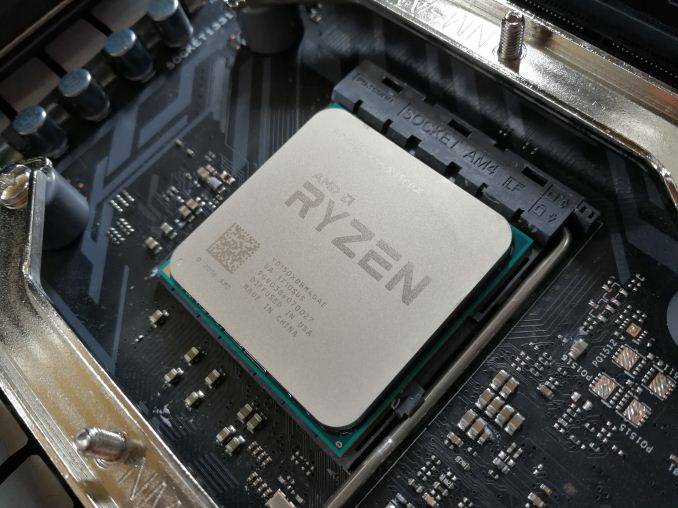 |
 |
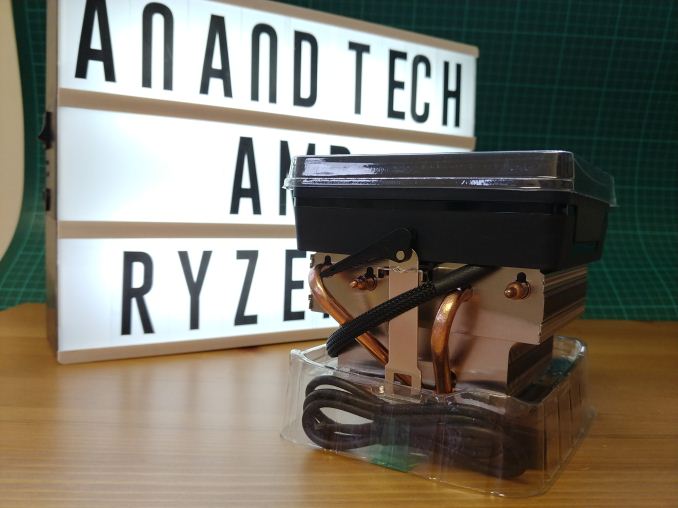 |
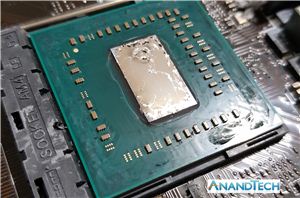 |
| Core Scaling | Memory Scaling | Graphics Scaling | Best CPUs |
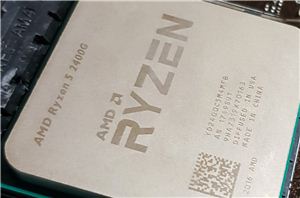 |
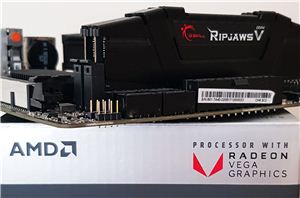 |
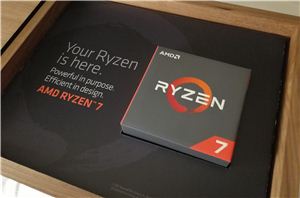 |
|


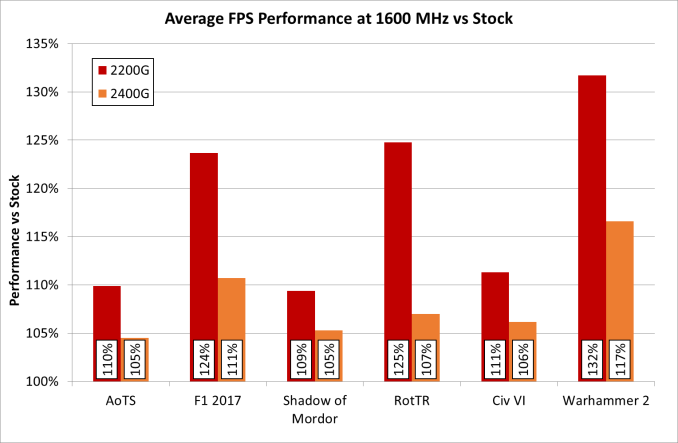
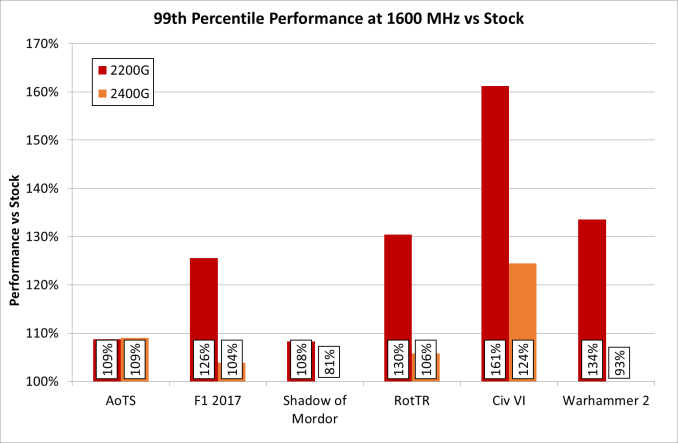
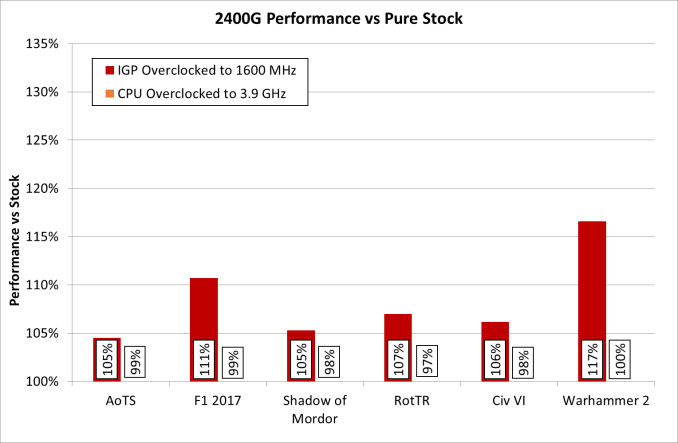
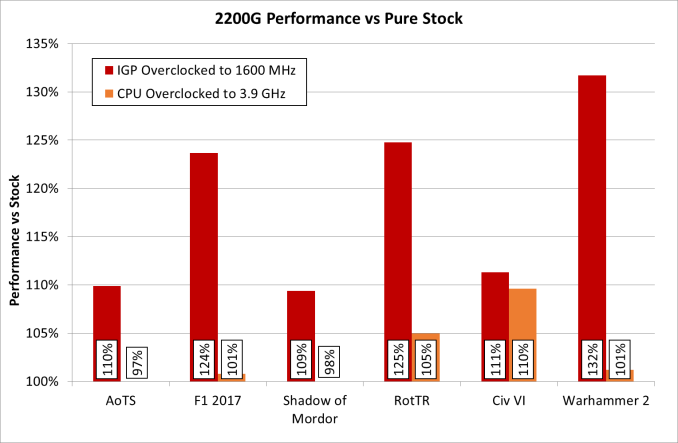
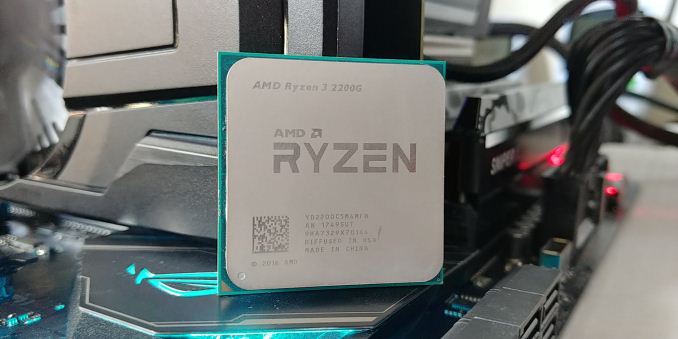








49 Comments
View All Comments
Lolimaster - Saturday, September 29, 2018 - link
There was an issue on the APU's were at certain frequencies the clock rate would jump around giving you nasty minimun (shown on many early reviews) and then after a certain threshold, the clock will not jump around like crazy, consistently beating the GT1030 at almost any scenario.ipkh - Friday, September 28, 2018 - link
So how about a Memory plus GPU overclock since those 2 combined would make the most difference.lightningz71 - Saturday, September 29, 2018 - link
Buildazoid showed that significant overclock on both the iGPU and the RAM was quite difficult. The iGPU reacted negatively to lower SOC voltage whereas the memory controller disliked higher SOC voltages. The happy medium seemed to be an iGPU at 1600mhz and running the ram at 3200-3400 mhz with the tightest possible timings. Leave the CPU cores at stock to maximize package power and thermal budget for the iGPU.The_Assimilator - Friday, September 28, 2018 - link
Anyone who knows discrete Vega knows it runs hungry and hot at stock frequencies and even worse when overclocked, but is far better behaved when underclocked and/or undervolted. Hence why these Vega iGPUs have so much OC headroom: they're deliberately being run slow in order to hit an acceptable power/heat target.Given that, the omission of power usage and temperature data from this review is glaring, to say the least.
jensend - Saturday, September 29, 2018 - link
I agree that 'overclocking scaling' reviews that don't show how power and temperature scale are failures. I wouldn't overclock the 2400G for tiny gains and large power/temperature/etc drawbacks.The one interesting conclusion that can be drawn from this piece is that the 2400G's shader etc performance at stock is high enough that at 1080p the bottlenecks are generally elsewhere (esp memory), while that's not as true of the 2200G. (We already kind of knew that from the memory scaling article.)
Nagorak - Saturday, September 29, 2018 - link
I agree, just posted the same myself.Lolimaster - Saturday, September 29, 2018 - link
Still the best reviewer for APU's, specailly OCing scaling and different resolution is techepiphany on youtube, shame on anandtech, they can't even do a proper review for an APU, just a lazy thing.Nagorak - Saturday, September 29, 2018 - link
I kind of feel like this is incomplete without some comparison of power use and heat generation. Maybe not at every frequency but it would be nice to see stock vs max OC at least. Based on the results with Vega GPUs it seems likely that efficiency craters as you go higher. It would be nice to know at least.neblogai - Saturday, September 29, 2018 - link
~50W higher power use is usually not an issue if total system power use is ~150W. But it would be useful to look at it from the point of motherboard SOC VRM ability. Raven Ridge chips are a budget option, so are usually used with cheaper B350 motherboards; however, those often do not have good SOC VRMs(and radiator on them) for extra power overclocked Vega iGPU consumes.notashill - Saturday, September 29, 2018 - link
The other big practical concern for budget builds is the need to spend more money on cooling. The cooler used in this review costs more than the 2400G so it would be totally nonsensical to actually use. Do they actually need crazy cooling to hit these overclocks, or is something like a $30 212 EVO enough?